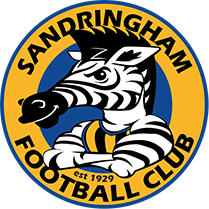From Inception to Triumph: The Journey of Sandringham Football Club to its 1946 Premiership
18/06/2024
The Sandringham Football Club, known as the Zebras, has a storied history in the Victorian Football League (VFL), formerly the Victorian Football Association (VFA). From its founding in 1929 to its first Premiership in 1946, the early years laid the foundation for the successes of the following years. The struggles, the development, to then the elation of triumph, follow along as we spell out the formation years of the mighty Zebras.
Founding and Early Years (1929-1939)
The Sandringham Football Club was established and admitted to the VFA. The Club was formed from a merger of local teams, with our club colours taken from the three merging sides - gold from the Sandringham Amateurs, black from Black Rock and blue from the Hampton Amateurs.
It was not until 1934 that the Sandringham Football Club officially adopted a mascot. The Zebra, a name coined by the “Sun News Pictorial”.
“Richmond as Tigers now have a rival in the animal kingdom, for Sandringham, in the yellow and black striped guernsey, resembled Zebras. The way they galloped away from Brighton to win showed they could emulate that animal.”
The team would then be known as the “Zebras”. Even during the leaner years of the Club, Sandringham played true to their name, playing with pace and true grit.
In its initial years, Sandringham faced challenges typical of a new club, including establishing a solid team and infrastructure. In an effort to arrest the slump the Zebras were going through, the Mayor of Sandringham called a meeting of those interested in the Club. The object was to improve the position on the ladder and improve the conditions at the ground, including a new press box.
The first decade saw limited success, finishing only as high as fifth in the early 12-team competition at the time. The first playing group began to retire from the game, prompting a new age in the Club. Recruiting local footballers turned the corner for the Club and success followed. Famed Zebras joined the side to take it into the new era: Neil Bencraft, Stan Tomlins, Frank (Ginger) Scanlon, Ian MacKenzie, Mick Middleton and Ian Cummings, all gave considerable service to the Zebs. Sandringham worked on developing a competitive team and fostering community support, a key characteristic of the Club which still lives on today.
Building a Competitive Team (1940-1945)
The Second World War proved to impact the Zebras significantly and we produced two of our poorest years (1940/41) since the team formed. As the seriousness of the war wore on, several players were scattered around the world on active service and it was a small core of players who drove the Club forward. A total of 43-players donned the Zebras guernsey in 1945, greater than any season to this point.
In the early stages of the 1945 season, a player supposedly on active service went A.W.O.L in order to play for the Zebras. During the game, Navy officers turned up to Beach Oval to arrest him. Club Officials persuaded them to wait until the final siren and they somehow obliged. Aware of the officers’ presence, the player positioned himself on the opposite side of the oval, and as the final siren rang, he ran and jumped the fence. He was able to avoid the officers for three weeks before being summoned back to Naval service.
Key to their eventual success was the focus on nurturing local talent and building a cohesive team. The Club's administration and coaching staff played significant roles in this period, laying the groundwork for future success.
First Premiership (1946)
1946 was a momentous year in every aspect of the Club. The formation of the Ladies’ Social Committee in the back end of 1945, with a social event every matchday, provided significant financial contributions as well as attracting greater attendances. The Club broke attendance records both home and away as the Zebras began to startle the football world with unexpected victories and soon became the glamour side of the V.F.A. The season concluded in our first ever finals appearance 17 years after formation.
To have a chance at a maiden premiership, Sandringham had to prove themselves against two of their fiercest rivals. In the semi-final, the Zebras played Port Melbourne. Stan Tomlins shone with seven goals in a hard and fair 29-point victory. The following week in the Preliminary Final, the Zebras faced Williamstown, the reigning Premiers. Williamstown were the only side not to lose in the regular season to the Zebras. In a sensational game, Sandy was down by 40-points at three quarter time. The Zebras ran home to snatch the victory by one point, 115 to 114.
In a maiden grand final appearance, Sandringham faced Camberwell in front of a crowd 30,000 strong at the St Kilda Cricket Ground. Camberwell led only by two points at the third quarter time break. This lead was insufficient for a fit Zebras side who stayed in the game to the very end. It was after the full-time siren that the Zebras extended their lead to seven points and secured their first ever Premiership.
The Premiership team brought about solidifying the Zebras as a competitive team within the VFA, after a lengthy period of hardship. The war had concluded and the Zebras were pushing forward once more, keen to become a prolonged force to be reckoned with. The period from 1929 to 1946 was foundational for the Sandringham Football Club, marked by initial challenges, steady improvement, and eventual triumph with their first Premiership. This era established the Zebras as a competitive force in the VFA and laid the foundation for future successes.
Written by Tom McQuillan - Sandringham FC Media






